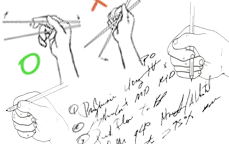 Developmental coordination disorder (DCD), also known as developmental dyspraxia, is a neurological condition that begins in childhood. It can affect the planning of movements and co-ordination due to brain signals not being transmitted accurately to the body.
Developmental coordination disorder (DCD), also known as developmental dyspraxia, is a neurological condition that begins in childhood. It can affect the planning of movements and co-ordination due to brain signals not being transmitted accurately to the body.
The word ‘dyspraxia’ comes from the Greek dys- meaning ‘difficulty’ and -praxia or more specifically “praxis” meaning ‘control of movement’.
Many of the difficulties that manifest in childhood can persist into adulthood. Problems are not only physical as memory problems, especially working memory, can also be present. Dyspraxia can also affect organisation, planning, time management and orientation. People assessed as dyspraxic may take longer than expected to learn new things as a result of these difficulties.
Dyspraxia has nothing to do with intelligence but many people with dyspraxia get overlooked in mainstream education as it doesn’t always affect reading and spelling. Dyspraxia/DCD as a neurological condition that can cause difficulties has only been recognized over the past 20 years so there are many adults who were undiagnosed and reprimanded for being messy, untidy and late for things. Up to 50% of dyspraxics are assumed also to have ADHD or overlapping dyslexia, dyscalculia and autistic spectrum disorders (ASD).
Dyspraxia Traits
Gross motor co-ordination skills

- Poor balance. Difficulty in riding a bicycle, going up and down hills
- Poor posture and fatigue.
- Difficulty in standing for a long time as a result of weak muscle tone.
- Floppy, unstable round the joints
- Poor integration of the two sides of the body.
- Difficulty with some sports involving jumping
- Speaking smoothly/fluently
- Poor hand-eye co-ordination
- Difficulty with team sports especially those which involve catching a ball and batting
- Difficulties with driving a car
- Lack of rhythm when dancing, doing aerobics
- Clumsy gait and movement
- Difficulty changing direction, stopping and starting actions
- Exaggerated 'accessory movements' such as flapping arms when running
- Tendency to fall, trip, bump into things and people
Fine motor co-ordination skills

- Lack of manual dexterity
- Poor at two-handed tasks, causing problems with using cutlery, cleaning, cooking, ironing, craft work, playing musical instruments
- Poor manipulative skills
- Difficulty with typing, handwriting and drawing. May have a poor pen grip, press too hard when writing and have difficulty when writing along a line
- Inadequate graspDifficulty using tools and domestic implements, locks and keys
- Difficulty with dressing and grooming activities, such as putting on makeup, shaving, doing hair, fastening clothes and tying shoelaces
Speech and language

- Poor self-confidence
- Low self-esteem
- Fitting in with peers confidently
- Maintaining a positive social status
- Maintaining a positive attitude
- Interpreting non-verbal actions (e.g. body language) of others
- Identifying social strengths and weaknesses
- Making and keeping friends
- Dealing with unexpected challenges
Perception of the senses

- Understanding and interpreting different senses
- Poor visual perception
- Over-sensitive to light
- Difficulty in distinguishing sounds from background noise
- Tendency to be over-sensitive to noise
- Over- or under-sensitive to touch.Can result in dislike of being touched and/or aversion to over-loose or tight clothing - tactile defensiveness
- Over- or under-sensitive to smell and taste, temperature and pain
- Lack of awareness of body position in space and spatial relationshipsCan result in bumping into and tripping over things and people, dropping and spilling things
- Little sense of time, speed, distance or weight. Leading to difficulties driving, cooking
- Inadequate sense of direction. Difficulty distinguishing right from left means map reading skills are poor
Learning thought memory

- Difficulty in planning and organising thought
- Poor memory, especially short-term memory.
- Unfocused and erratic.
- Poor sequencing causes problems with maths, reading, spelling and writing reports at work
- Accuracy problems. Difficulty with copying sounds, writing, movements, proofreading
- Difficulty in following instructions, especially more than one at a time
- Difficulty with concentration.May be easily distracted
- May do only one thing at a time properly, though may try to do many things at once
- Slow to finish a task. May daydream and wander about aimlessly